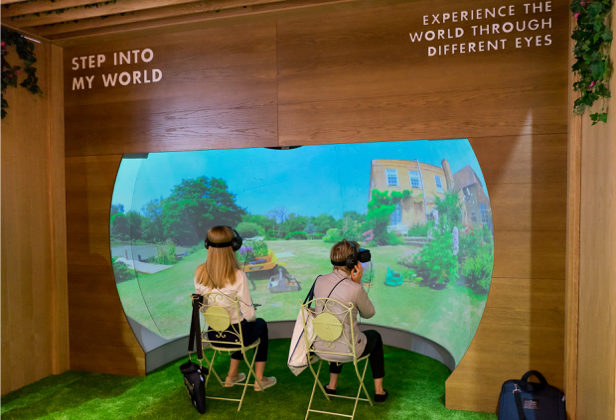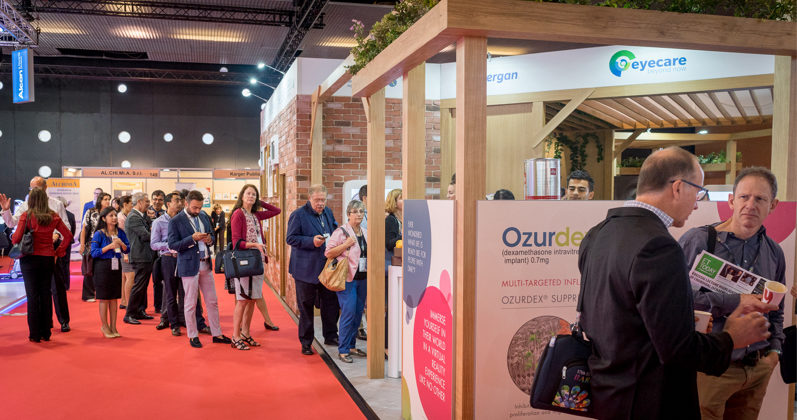Seeing the world through someone else’s eyes: storytelling with Allergan and Jaunt
Blurring the lines of reality with to tell compelling and empathetic stories is at the heart of many virtual reality experiences. When leading cinematic VR company, Jaunt, was approached by Allergan to produce a new VR experience, they had a clear vision on how to craft a dramatised story that conveys a medical topic with scientific integrity while entertaining the audience, with a real focus on storytelling.
Objectives
Leading pharmaceutical company Allergan wanted to create an immersive experience as a central part of its exhibition stand at the Euretina 2017 event in Barcelona (the largest of its genre globally), believing it could help to increase footfall and engagement amongst the B2B audience of medical professionals in attendance.
The experience’s objective was to raise awareness of a medical condition, Diabetic Macular Edema (DME) and showcase the impact that using an Allergan product, Ozurdex, could have on alleviating symptoms for sufferers, who experienced varying forms of visual impairment. The experience had to be both memorable, so that physicians would remember Ozurdex when treating patients in the future, but also scientifically accurate at all times when representing the condition and the impact of the treatment.
To achieve this, Allergan tasked Jaunt with creating a compelling VR experience that would ‘make sure that physicians understand it’s a patient behind the eye’.
“We believed the most impactful approach was to create a dramatic, narrative-driven story that invoked emotion and empathy whilst offering positivity and hope.”
— Marco Delvai, Jaunt
What was produced
A four-minute, high quality stereoscopic 3D VR experience was produced by Jaunt. A fictional story was developed with Jaunt’s longstanding partner and award-winning VR and Theatre director, Steye Hallema, and featured a dramatic narrative arc in order to hook the audience from start to finish.
The film tells the fictional story of a woman who suffers from DME. It shows what the impact of living with such a condition treated with standard available drugs has on her, and also on her family. Set mostly in and around the protagonist’s home, her eyesight starts to fail after she decides to stop the treatment due to the psychological and physical strain that is caused by the monthly eye-injections that she requires. This leads to difficulties in undertaking everyday tasks, such as driving. The story takes a more dramatic turn when her small granddaughter goes missing whilst in her care. Her blurred eyesight makes it difficult to find the young girl, and although they are successfully reunited, the panic felt culminates in the protagonist realising she needs to re-start the treatment to improve her sight, despite the side-effects of the injection. There is resolution at the end of the experience, which ends positively with her condition improving thanks to her Doctor treating her with Ozurdex, a new drug available to patients which drastically reduces the number of injections needed, to only two per year.
In addition to creating a dramatic narrative, the Jaunt team believed it was also important to make a large part of the film from the protagonist’s point of view, so as her eyesight deteriorates, the viewer gets to experience what it feels like to suffer DME symptoms. The viewer also gets to hear the protagonist’s internal monologue; reinforcing her fears and panic throughout the experience to amplify the viewer’s empathy.
 Challenges in development
Challenges in development
The development of the script presented the Jaunt team with the biggest challenge of the project. The pharmaceutical industry in the UK (and generally, worldwide) has stringent rules on how medical conditions and the treatment’s impact are represented, and the film had to strictly follow these. Marco adds that this was further complicated “as the experience was being shown in Barcelona, it also had to adhere to Spanish regulations as well. This meant the script was constantly changing as every element was closely scrutinised, culminating in 18 different iterations.”
In developing an accurate script, a large part of Jaunt’s pre-production planning was spent researching the condition to ensure it adhered to regulations, and also the most accurate and recent scientific research on the subject. In doing this, they found the available research into the manifestation of symptoms, showed a huge variation between sufferers. This added an additional unforeseen challenge in accurately representing the deterioration of sight, so spending time talking to patients to see which symptoms were most commonly experienced was crucial.
Nasreen Eldawi, a Production Manager at Jaunt, who oversaw the entire production phase of the film adds: “we worked with a number of established universities and research companies, facilitated or introduced by the client. One of these included City University London’s Research Lab, directed by Professor David Crabb at City University who were really helpful in providing us with research data and scientific papers about all research they had undertaken on DME. We also interviewed patients; this was essential to help us to try and condense for a short film what are the most likely and recurrent manifestations of DME as it varies so much from patient to patient.”
Production
As sight was at the heart of the experience’s narrative, capturing high quality images was important in enhancing the experience’s effectiveness in portraying the devastating impact DME can have on sufferers.
Filming took place over three days, on location in Surrey for two days and one day in London, with a crew of 11 people. Cutting edge kit was used, including the Jaunt One camera to capture high quality, 360 stereoscopic images and a Motion Impossible ‘Mantis’ Dolly which was used to add movement in a realistic way to accurately film the point of view of the protagonist.
“We were lucky to be filming on one of the sunniest days of the year. As the majority of the action takes place in a vibrant environment, this reinforced the narrative of protagonist’s failing eyesight.
— Nasreen Eldawi, Jaunt
Accurately portraying the symptoms of DME was crucial not only from a regulatory perspective, but also to add authenticity to the piece. Failing this would have undermined the whole project. Creating this was not as easy as first assumed, and Jaunt brought in a Unity expert to help to produce the effect of blurred vision.
Exhibiting the experience
The experience was showcased at the Euretina 2017 event in Barcelona where over 600 medical professionals got to experience the VR piece. Having a purpose-built stand to showcase the film was essential to maximise impact. As Marco notes, “the stand itself stood out on the exhibition floor and really helped to create a sense of drama. As attendees passing the stand could see the film on custom built screens, this had the effect of sparking people’s curiosity, which encouraged them to try the VR experience on Gear VR headsets.”
Impact and future
The experience was highly successful in achieving the objectives that Allergan initially set out to achieve, increasing footfall and engagement with attendees. Comments were overwhelmingly positive, including “I’ve never seen anything like it and I feel it was an extremely useful way of understanding what many of the patients I see every day actually experience”. This success has opened up additional opportunities for Jaunt to re-purpose the film, localising it for Allergan in regions around the world.
Marco sees that immersive technologies can offer unique opportunities for companies to raise awareness of their products in the future. He notes:
“Often in the pharmaceutical industry, promotional materials can be very dry. This experience highlights how taking a more creative approach with virtual reality in a dramatic way can be incredibly impactful.
